Spoiler season is here, and Magic is getting its second generation of Gods. Mark Rosewater acknowledged the importance of this series of designs in his column yesterday (which also previewed our first God, Hazoret the Fervent):
As an old math teacher loved to say, once you have two points, you have a line. Whatever we did in Amonkhet would begin defining what exactly it meant mechanically to be a God.
The new Amonkhet Gods, combined with the Theros gods, pretty much define what godhood will look like (generally speaking) in Magic. When we eventually see Magic’s take on other top-down, god-heavy mythologies such as Norse mythology, we’ll expect to see something resembling what we’ve already seen. And that takes us to the sixteenth god ever, Hazoret the Fervent:
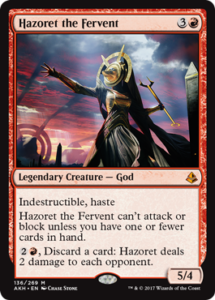
What Makes a God a God?
We now see the enduring traits of godhood:
- The god creature type (duh)
- Indestructibility
- A static ability which makes the god not always a (usable) creature
- An activated/static/triggered ability.
- A high power/toughness ratio for its mana cost (which justifies the hoops necessary to make it a creature)
This feels pretty good to me. Gods don’t always show up in combat, but when they do, they wreck face. They’re difficult to deal with as creatures, but they don’t justify their cost when they’re not a creature.
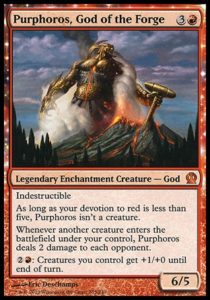 How do the gods differ?
How do the gods differ?
Hazoret is very different from the Therosian Gods. Hazoret is a murder weapon, pure and simple. Her job is to straight up kill players, and to do so as a creature.
This is quite different from before. Many of the old Gods played as reasonably strong enchantments that could eventually turn into creatures (Thassa, God of the Sea, Purphoros, God of the Forge, Erebos, God of the Dead, Xenagos, God of Revels, Athreos, God of Passage, and Keranos, God of Storms, to name a few). The Gods of Theros did a lot of work from afar without having to sully their hands in combat. Even the most aggressive gods, Mogis, God of Slaughter and Iroas, God of Victory did a decent amount of work as enchantments: Mogis served as a Sulfuric Vortex/The Abyss while Iroas was a Dolmen Gate/Goblin War Drums hybrid.
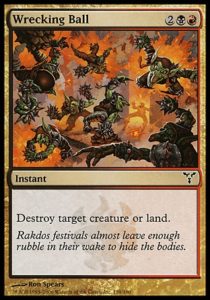
Murder, Kill, Destroy!
So, Hazoret the Fervent‘s activated ability is a lot worse than the average Therosian god’s ability, but she’s much, much easier to turn into a creature and a much more focused design. She kills players dead. The core of this is Hazoret’s condition on being a (usable) creature, which is much easier to achieve and less taxing on deck construction than devotion.
Devotion demands a lot of a deck: you need many permanents of particular colors, and a devotion-intensive deck is rewarded for playing color-intensive cards which punish you for playing other colors. You need to go wide on the board and deep on a single color (or a color pair, as was the case the two-color Gods). This made the gods relatively easy to keep from being creatures: even though the God was immune to most forms of creature removal, any creatures generating devotion weren’t. In return for devotion being disable-able, the Gods had fairly powerful abilities even when they weren’t creatures.
Hazoret the Fervent has a much looser restriction on deckbuilding: she wants to be in an aggressive deck. She gets additional benefit from madness cards and rewards discarding your cards for value, but she works just fine as a curve-topper that’s almost impossible to kill, casts Lava Axe/Cruel Edict every turn, and turns cards into mini Lava Spikes. Furthermore, this is an almost-impossible-to-interact-with condition: it’s not like there are lots of ways to force your opponent to draw cards, and if that’s your solution to Hazoret, then you have bigger problems. You could bounce cards back to their hand, but that’s about it.
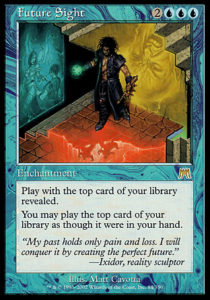
Looking Ahead
I’m excited to see the other Gods’ trigger conditions. I’m fairly certain the other four will have different ones than Hazoret—being hellbent isn’t exactly in blue, green, or white’s wheelhouse, particularly in this Standard format where white and green have some of the best card advantage. I also wouldn’t be surprised if they follow in Hazoret’s vein and only justify themselves if you can turn them into creatures. Perhaps the blue god might not be as keen to get into the thick of things—or it’ll follow Thassa’s example and be the best one as a flying, evasive beater.
It’s also worth noting that Hazoret wasn’t intended to be in Standard alongside Grasp of Darkness. I don’t know what answers to Hazoret are in Amonkhet, but there don’t seem to be many decent removal spells currently able to kill indestructible creatures. Perhaps the Gods are supposed to be very difficult to deal with, though I’d be worried about another wave of difficult-to-answer threats entering Standard. Then again, Hazoret is pitifully small compared to Heart of Kiran‘s power/toughness to mana cost ratio.
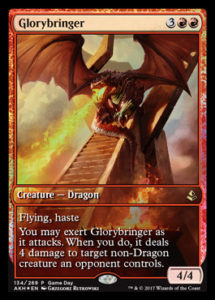
A Spike God?
As a parting note, I find it fascinating that Wizards chose Hazoret as the first god to be spoiled. I feel like she’s an incredibly enticing Spike card, but far less exciting a card for Tammies/Timmies and Johnnies/Jennies.
She’s very focused on doing one thing, as opposed to the Theros gods which were almost always about doing two things (the first one was always beating face with an indestructible god), or three things in the case of Theros’ monocolored gods. Because Hazoret is easier to animate, she has a smaller power and toughness than the four-drop Therosian Gods—Ephara was a 6/5, Erebos a 5/7, Heliod a 5/6, Iroas a 7/4, Mogis a 7/5, Nylea a 6/6, and Purphoros a 6/5. She creates fewer constraints on deckbuilding and even helps you solve her puzzle by herself. Having trouble dumping your hand? She does that for you! There’s just less you can do with her, aside from murder people.
Now, that’s not a problem (in the world of collectible card games). Hazoret the Fervent likely generates a whole mess of excitement and is going to win a lot of games (and likely be way more miserable to play against in Sealed than the gods of Theros). That said, I’m surprised they didn’t lead with a God with more cross-psychographic appeal. Perhaps all of the Gods have a strong Spike bend. Or perhaps I’m wrong about Hazoret’s appeal and there’s much more to her for Timmy/Tammy and Jenny/Johnny than I give her credit for.
All I know is that I can’t wait to see the other Gods spoiled and I can’t wait for another new Limited format. Until then, and as always, thanks for reading.
—Zachary Barash
Zachary Barash is a New York City-based game designer. He learned Magic in 1994 and is still afraid of Living Wall (don’t click it! It’ll see you). He’s currently pursuing his MFA in Game Design at NYU and designing for Kingdom Death: Monster. His favorite card of the month is Spell Snare, a counterspell which trades efficiently on mana but only in an extremely limited situation. Also, it’s a counterspell that can’t counter itself, and that’s just nice.

